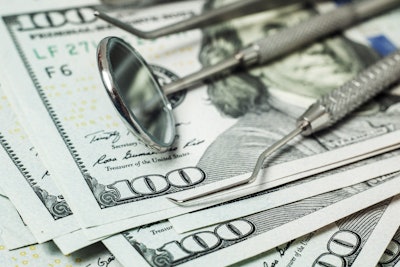
Multiple factors, including gender and dental practice model, and their complicated interplay make determining the expected wages of dentists working in the U.S. difficult. The commentary was published on October 1 in the Journal of the American Dental Association.
Clinicians should weigh these factors when making career decisions, the authors wrote.
"The presence of observable patterns and themes in some factors of wage determinants will help in setting realistic expectations in dealing with financial aspects of life after graduation," wrote co-author Dr. Siew-Ging Gong, MS, MA, PhD, of the University of Toronto.
Since 2000, student debt for new graduates and practicing dentists in the U.S. has climbed steadily while wages have stayed stagnant. About 66% of dentists who graduated in 2001 still had student debt of $108,000 nearly 12 years later, and their debt often mounts by taking out more loans after graduation, according to the commentary.
Furthermore, predental and dental students have reported that they anticipated making between $100,000 to $300,000 within five years of graduating. The U.S. Bureau of Labor Statistics and the ADA support these salaries, the authors wrote.
However, clinicians must consider other elements like the practice model. For example, dentist owners made median annual net incomes of $172,040, while dentists who were co-owners made $230,070 and dentist employees earned $168,390. However, dentist employees at dental service organizations also often receive additional benefits, including health insurance, continuing education reimbursement, a pathway from associateship to ownership, and stock ownership. Together, these benefits can add an extra $1,000 in value per month to a dentist's existing salary, they wrote.
Another factor to consider includes gender. Pay gaps continue to exist between male and female dentists. In 2022, the median annual pay of women dentists was 79% that of male dentists, which broke down to $158,308 for females and $200,421 for men, they wrote.
Though wage gaps between the genders remain largely unexplainable, some reasons may be that female dentists perform more preventive care and fewer surgical procedures. Also, women are less likely to own their practices, they may be more inclined to accept lower compensation, as well as treat Medicaid patients, the authors wrote.
"There are variables that determine the wages of dentists," Gong and co-author Dr. Dennis Park wrote.




















